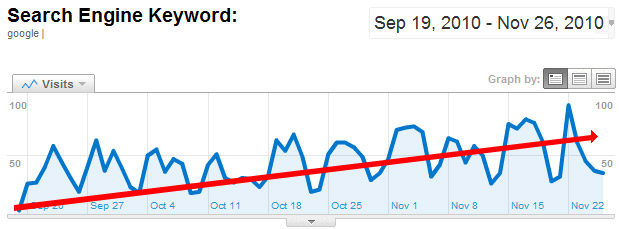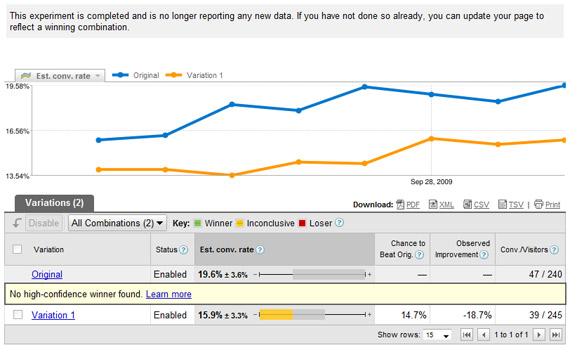A/B testing SEO landing pages can be more tricky than testing an email or pay-per-click campaign, especially when you are using a tool like Google Website Optimizer. There are a few precautions you should take to make sure you obtain accurate test results and to not damage your previous SEO efforts. Read below to find out why.
Let’s Clear A Few Things Up Before We Begin
This post is not about testing different variations of a SEO landing page to see which version attracts more traffic from the search engines. This post is about how to test SEO landing page variations to see which version converts higher for a desired goal. An easy example that would help illustrate this point would be the desire to enhance a product page that will ultimately send more visitors to a checkout page. You obviously want the product page to rank high in the search engines, but the point of testing the product page is to achieve the highest possible conversion between the product page and the checkout page.
Also, I will be talking a lot about landing page variation “A” and “B”. Variation “A” will be the first SEO landing page you build and the first that will be live on your site. Landing page “B” will be the first test variation of “A”. Finally, a “landing page” refers to a webpage specifically designed to attract search engine traffic for a particular keyword.
Since You Will Be Testing SEO Landing Pages, Make Sure They Are Optimized!
Here is a checklist of important on-page SEO items you will want to focus on when you create your first SEO landing page:
- SEO friendly URLs:
- Title Tag:
- H1 Heading:
- Bold the keyword once in the text:
- H2 Headings:
- Images With Alt Text:
- External Links:
If your website is able to have SEO friendly URLs, then do so. Simply make sure you have keywords in your URLs and separate each word by dashes. For example: https://example.com/seo-friendly-urls
The title tag is the biggest influencer in terms of “SEO weight” for any webpage. Include the keyword near the beginning of the title tag.
The H1 should match the title tag if possible. Again, be sure to include the keyword in the H1 heading.
You may want to bold the keyword once and make sure it appears in the body text.
It’s a good idea to have a couple H2 heading tags to act as sub headings. These sub headings should include keywords that are similar or related to the main keyword.
Images provide a better user experience, so try to include a couple images on your landing page that contain descriptive alt text.
In order to show the search engines how your landing pages is related to other pages on the web, place a few links for “further reading” or to include “references”.
Finally create separate landing pages for all the keywords you want to rank for. I generally recommend for service based businesses to build niche landing pages for each service they provide. For example, if you’re dealing with a landscaping business, you may want to create landing pages for “walkway lighting”, “irrigation”, and “putting green installation”, because these would all be pages of different services the landscaping business provides.
What To Test
We have covered what to test extensively in this series. However, here is a quick list of webpage elements that can be tested:
- The headline.
- Your call to action.
- Any graphic you use in direct correlation to your sales efforts.
- The sales copy or product descriptions.
For more information please read this blog post: A Beginner’s Guide To A/B Testing: An Introduction
Launch Version “A” And Wait
A critical part of launching your first SEO landing page is that you have to wait for the page to get indexed by the search engines. The reason for this is to make sure you have enough traffic to run an A/B test. You need to hit a certain threshold of traffic in order to generate results worth analyzing.
If you are building links toward your landing pages, you should wait until those links are acquired and wait about a month for the “link juice” to be applied to those pages. Watch your analytics and wait until traffic to that page ramps up and levels out. Then you will be ready to run your tests.
Make Sure Variation “B” Does Not Get Indexed
A/B testing tools like Google Website Optimizer require you to build landing page variations on separate URLs. Anyone familiar with SEO will automatically see this as a “duplicate content” issue. Some people don’t think this is a big issue when it comes to A/B testing, but I think it can be (especially if you’re a small site without much search engine trust) and I think it’s better to be safe than sorry.
Since you will be testing two different web pages with very similar content and are about the exact same subject matter, you will want to make sure that you keep variation B out of the search engines. Here’s why:
- Keyword Cannibalization: By having two live URLs on the same topic, the search engines will get confused on which landing page variation will be the more important version to index. What will happen is the search engines will choose the more important page arbitrarily and therefore only send traffic to one page (or a majority of the traffic). This can cause damage your previous SEO efforts. Read more about keyword cannibalization here.
- Duplicate Content Issues: In regards to search engine optimization you almost certainly want to minimize the amount of repetitive content on your site. Your goal should be to have most of your site consist of unique content if possible. By have two URLs with very similar content, chances are you will be given a duplicate content penalty. A similar result would happen in the keyword cannibalization issue mentioned above, where the search engine would “pick” one URL over the other.
How To Make Sure Variation B Doesn’t Get Indexed
- Apply a meta “No Index” tag to the landing page B head. This will instruct the search engines to not index landing page B.
- Apply the canonical reference to landing page A in the landing page B head. This will tell the search engines that landing page A is the original version among to the two landing pages.
- Don’t mention variation B in your robots.txt file. There is no point in alerting others that this page exists. Sometimes this is a way to actually get a page indexed that you don’t want to get indexed (because other “bad” robots can follow those URLs and link to them elsewhere on the web).
Run, Rinse, and Repeat
Once your A/B tests are ready to begin, let ’em rip and monitor your website testing software to see how each variation is performing. Most website testing tools will give you real time feedback as to how each page is fairing. They will also let you know when you have hit a statistically significant threshold where you can make a decision on which landing page variation was the winner.
If your variation B landing page turns out to be a winner by a long shot, then congratulations! Now you can make variation B the new A and prepare for another series of tests.
What if the difference in results is minimal?
This is indeed a problem with A/B testing webpages. If the results between your tests are not significant enough you will have to keep testing drastic variations until you find a winning variation that produces significant results. Your website testing tools will alert you if your test did not hit a statistically significant result.
Will The Winning Page Hurts My SEO?
It’s possible that your winning page may alter your H1 headings, body text, and other on-page factors that affect the SEO of your landing page. This could change the search engine result ranking of your landing page. However, it’s far more important to increase the conversion power of a landing to page than to worry about the somewhat negligible effects on-page modifications will have.
Besides you should be continually link building towards your landing pages and increasing the overall traffic to your site externally. You don’t want to drive a ton of traffic to a page that converts poorly do you?
Conclusion
With tools like Optimizely, you can easily test different variations of your SEO landing pages. You just have to use a little caution when preparing your tests and be sure to give any new SEO landing pages enough time to build up enough traffic to make testing fruitful.
With that said, please leave some comments as to your thoughts on this post and what other things first time testers should be aware of.
About The Author: Sean Work is the former marketing coordinator at KISSmetrics. Follow him on twitter (@seanvwork) and ask him for a free cup of coffee 🙂


Comments (17)